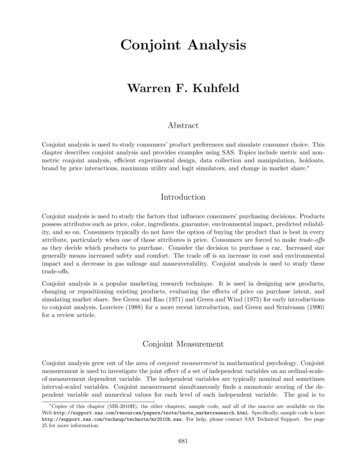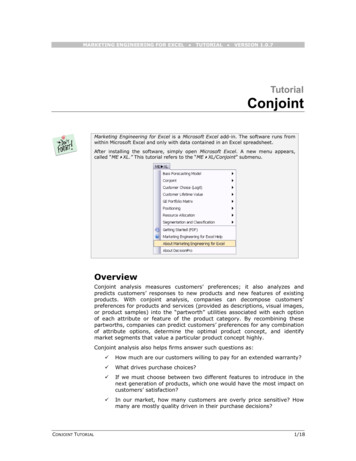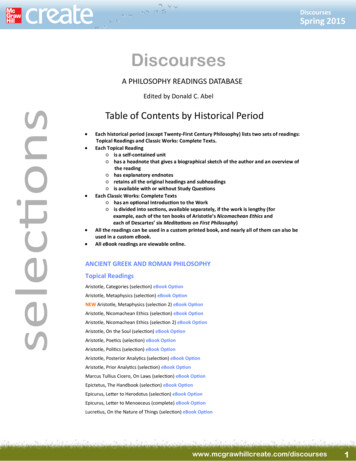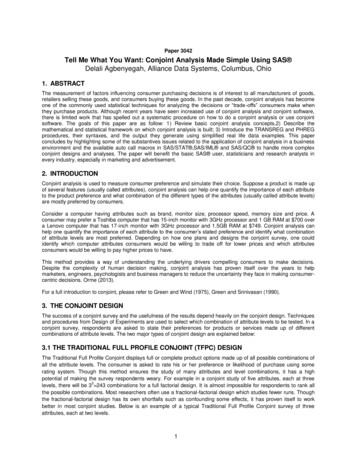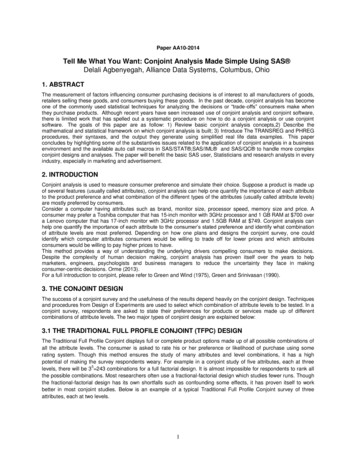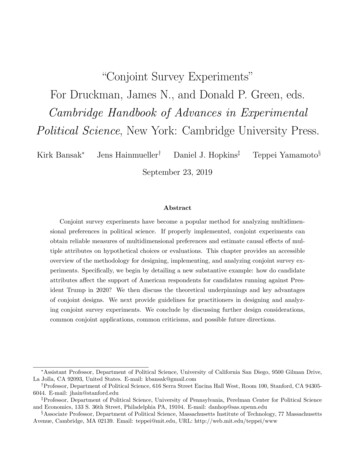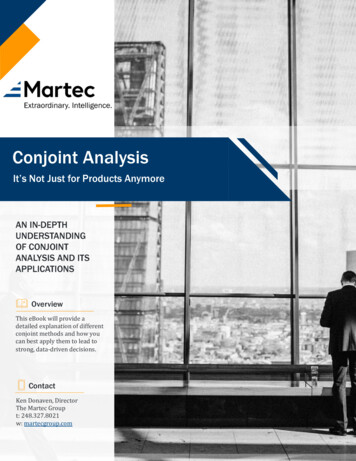
Transcription
Click to edit master title styleEdit Master text stylesConjoint AnalysisIt’s Not Just for Products AnymoreAN IN-DEPTHUNDERSTANDINGOF CONJOINTANALYSIS AND ITSAPPLICATIONSOverviewThis eBook will provide adetailed explanation of differentconjoint methods and how youcan best apply them to lead tostrong, data-driven decisions.ContactKen Donaven, DirectorThe Martec Groupt: 248.327.8021w: martecgroup.com1
FOREWORDWho We AreThe Martec Group is a global market research firm headquartered inDetroit, Michigan. With more than 35 years of experience, Martec iswell-equipped to provide actionable intelligence to leadingcompanies worldwide.The Martec team shares an important trait: We are motivated towork hard, diligently, and efficiently. We are unshakeable believersin excellence and do not rest until our clients have the insights theyneed to move forward with confidence.Learn more at martecgroup.com.22
INTRODUCTIONAlthough it may be cliché to start with a statement like “throughout thehistory of commerce,” in this case such an all-encompassing statementmay be justified. Essentially since the invention of the wheel, productmanufacturers have asked, “what makes my product valuable and sets itapart from the competition?” and “how can I maximize the value, price,and profit for my product?”The right features – or combination of features – can make the differencebetween a huge success or total failure. However, determining whatbuyers want and effectively marketing those differentiating features canbe challenging.Conjoint analysis is a powerful tool and can be used to quantifyseveral metrics, including product and feature value, trade-offscustomers are willing to make, and (in some cases) price elasticity fora product, feature, or brand.Gone are the days of guessing what customers want. Organizations cannow understand, early in the product development cycle, what customersvalue and what they are willing to pay for specific features beforeinvesting millions.This eBook will explore the differences in various conjoint methodologies,present case studies, and offer some best practices to help you determinewhich conjoint is the best methodology for your project.33
Click to edit master title styleEdit Master text styles1Conjoint Introduction2CBC In-Depth3ACBC In-Depth4MaxDiff In-Depth5Key Success FactorsConjoint AnalysisTABLE OF CONTENTS4
Conjoint IntroductionWhat is conjoint analysis?“In the beginning,” conjoint was used almost exclusively for productresearch; few other applications or objectives were appropriatefor conjoint.Essentially, a product was broken down into attributes andcustomers were asked to trade-off between those parts. Thisallowed researchers to understand which attributes drove customerpreference for a select rtisingPriceToday, conjoint can be used for much more than just productresearch. It is a tool that researchers use to understand pricing andprice elasticity. It is used for product development by allowingresearchers to understand how a new product may disrupt amarket. It is used to prioritize various product features, brands, orservices to help companies better understand what “moves theneedle” and which marketing messages will resonatewith customers.55
A Brief History Lesson1970Adaptive Conjoint Analysis (ACA)In the 1985, Adaptive Conjoint Analysis (ACA) was developedas a computer-based program that adapted to respondentanswers. Until the early 2000s, ACA was executed through acumbersome phone-mail-phone methodology. Respondentswere recruited via phone, mailed a floppy disk with the ACAprogram, and then phoned again.either to talk the respondentthrough the exercise or to remind them to complete it.1990Card SortWhen conjoint was first developed, it was based on a “cardsort” platform that required in-person interviews with therespondent base. The researcher would ask respondents toliterally sort cards, with various product configurations, frombest to worst. The card sort was then tabulated and used tounderstand customer preferences and which attributesimpacted customer preferences.1985Conjoint has evolved significantly since its introduction in the 1970s.Choice-Based Conjoint (CBC)In the 1990s, Choice-Based Conjoint (CBC) was introduced.CBC is a simplified, non-adaptive trade-off analysis. Thismethodology eliminates the rating and ranking of attributesand shows respondents full profiles of configured products.Respondents are asked to choose their preferred option over aseries of questions. It is best used for pricing studies, forproducts or services with less than five attributes, and topredict product or service choices and preferences.66
2000A Brief History LessonMenu-Based Conjoint (MBC)In the 2000s, Menu-Based Conjoint (MBC) was introduced.MBC is an advanced discrete choice modeling system thatallows users to choose from multiple menu options. It can bedesigned to show a bundled product or allow respondents tochoose a-la-carte.2010MBC is not used very often but it provides greater designflexibility by providing the option of having a basket ofproducts from which respondents can make their choices.Adaptive Choice-Based Conjoint Analysis (ACBC)The most recent addition to the conjoint family is AdaptiveChoice-Based Conjoint (ACBC). This was introduced in 2010and was designed to mimic the purchase decision process forcomplex products and services. ACBC combines many of thebest features of Adaptive Conjoint and Choice-Based Conjoint.ACBC works in a series of steps designed to identifyrespondent preferences and simplify the choices throughoutthe exercise. ACBC takes respondents through three exercises:1. Build your own: Create a product with all your preferredattributes2. Screening: Create a consideration set and establish rules3. Choice tasks: Choose which option is best from theconsideration set77
Conjoint ApplicationsWhat is conjoint used for?Product DesignWhen designing a new product, conjoint can beused to determine whether (or how much) newproduct features will impact customer preference.It also can help companies understand how various productconfigurations might impact that preference. Conjoint can measurethe potential acceptance of a holistic new product and how thatproduct might disrupt the market.Price ElasticityNeed to better understand price elasticity and theimpact of price on customer preference? Conjointcan help.Not only can conjoint help companies determine the impact a priceincrease may have on preference, it also can help reveal the impactindividual product features can have on both preference andwillingness to pay.When launching a new product or new product feature, it can helpcompanies understand, “will this new feature allow us to charge ahigher price and capture a better margin?”88
Conjoint ApplicationsWhat is conjoint used for?Brand ValueUnderstanding the value of a brand can be achallenge for companies and researchers.However, a version of conjoint that includesdynamic pricing has removed some ofthe challenge.Adaptive Choice-Based Conjoint can be used to isolate brand in thepurchase process and provide insights into both the intrinsic valueof the brand and its impact on customer preference andprice elasticity.Attribute ValueFinally, conjoint is a great tool for measuring theimportance of – and customer preference for –various product features and attributes.Conjoint provides a better understanding of attribute importance bydetermining both the “value” of each attribute and the value of eachlevel within an attribute. Returning to the brand example, we maylearn that “brand” as an attribute is not very important, but Brand X,a level within the brand attribute, is vastly preferred over Brand Y orBrand Z.99
Understanding Different MethodsA high-level overview of each conjoint productAdaptive Conjoint Analysis (ACA)It is most frequently used for modeling highly involved purchasesand new product development research.ACA consists of a three-step process in which respondents: Rank the attributes by preference Assign importance to the attributes Determine preference by evaluating which of two presentedoptions is most preferredAdvantagesDisadvantagesMinimizes “information overload”Must be administered onlineUp to 30 attributesProcess is more abstract andchallenging for respondentsAdaptive using artificial intelligence(AI)Not ideal for price sensitivityGenerates realistic trade-offs1010
Understanding Different MethodsA high-level overview of each conjoint productChoice-Based Conjoint (CBC)CBC is much less abstract than ACA because it presents more likereal-life product decisions that customers may be making. It canbe completed in-person or via phone, depending on the numberof attributes and levels.There are multiple varieties of CBC, including: “Choose one” approach – “Which of these computers wouldyou buy if these are the only options available?” Chip allocation – “In your next 10 purchases, how many ofeach product would you purchase?”AdvantagesDisadvantagesLess abstract – similar to real-lifedecisionsStatic questions – does not adapt torespondent choicesCan be administered via multiplechannels (online, in-person, phone)Not appropriate for complexproducts and services1111
Understanding Different MethodsA high-level overview of each conjoint productMenu-Based Conjoint (MBC)MBC lets respondents package their own product or service. Itworks like advanced discrete choice modeling, allowingrespondents to select multiple options from a menu. With thismethod, respondents can choose what they want in their idealproduct while keeping price as a factor in their decision.AdvantagesDisadvantagesAllows greater customization ofproducts and attributesMore complicated to program andexecute than other conjointmethodologiesProvides more realistic productconfigurationsNot appropriate for simple productsand servicesEnables more precise understandingof price sensitivity1212
Understanding Different MethodsA high-level overview of each conjoint productAdaptive Choice-Based Conjoint (ACBC)ACBC combines elements of CBC, artificial intelligence, and(optionally) dynamic list-building. ACBC requires more up-fronttime for survey design, particularly for dynamic pricing/listbuilding. However, the data provided, both on an overall and perattribute basis, is more in-depth than either ACA or CBC. It allowsfor greater customization and more accurate analysis.AdvantagesDisadvantagesMore realistic and engaging forrespondentsTakes longer to administerCaptures more information for eachattribute or level, allowing for morecustomized and accurate analysisNot ideal for simple products andservices with few attributesMust be administered online1313
1Conjoint Introduction2CBC In-Depth3ACBC In-Depth4MaxDiff In-Depth5Key Success FactorsConjoint AnalysisTABLE OF CONTENTS1414
Choice-Based ConjointWhat is CBC?Choice-Based Conjoint (CBC) is the most popular conjoint moduleand offers a more simplistic way to gauge respondent interest inproduct attributes, brands, and more. It simulates real-lifeproduct decisions.Respondents are shown screens with set product configurations(does not adapt based on responses):This methodology: Is less abstract than ACA and simulates real-worldbuying decisions Can be conducted online, in-person, or via phone Success of in-person or phone surveys will depend on thenumber of attributes Often takes less time than either ACA or ACBC Allows for more robust ancillary questioning1515
Choice-Based Conjoint Case StudyBusiness ChallengeCase StudyUltra-thin TVpricingA global consumer products manufacturerrequired consumer insights regarding TVthickness and bezel width. Further, itwanted to determine if consumers will paymore for an ultra-thin TV to determine ago/no-go decision regarding future productdevelopment.OutcomeMethodology200 onlineconsumerinterviewswith choicebased conjoint Through CBC, we determined TVthickness, frame width, and bezel widthall have a significant impact onconsumer preference Consumers preferred a thinner TV witha thinner bezel until its price premiumwas 33% higher than a thicker TV Pairing the thin TV with the mostpreferred brand yielded even higherprice premiums Based on the research, the decision wasmade to move forward withdevelopment of the ultra-thin TV1616
1Conjoint Introduction2CBC In-Depth3ACBC In-Depth4MaxDiff In-Depth5Key Success FactorsConjoint AnalysisTABLE OF CONTENTS1717
Adaptive Choice-Based ConjointWhat is ACBC? Adaptive Choice-Based Conjoint (ACBC) is designed to addresscomplex products and services It leverages the best aspects of both discrete choice modelingand ACA It is highly interactive and adaptive to the preferences andopinions of each respondentACBC interviews progress like this:1. Build your ownThe ACBC approach begins with a “buildyour-own” exercise, which allowsrespondents to configure products andservices to their specific needs and wantswhile considering the price premium ordiscount associated with the pre-definedattributes and levels.2. ScreeningUpon designing their “ideal” product orservice, respondents are asked to evaluateseveral configurations with similarfeatures to determine “must have” and“never have” features.3. Choice tasksWith the consideration setfinalized, respondentscomplete a choice-basedexercise, very similar totraditional CBC, in whichthey are asked to identifythe “best option.”1818
Adaptive Choice-Based ConjointHow can ACBC help?Adaptive Choice-Based Conjoint has several inherent advantagesover other conjoint methodologies: It keeps respondents more engaged and connected to theresearch process It allows for a better understanding of the specific value ofindividual features Versus traditional trade-off research, which typically focuseson the overall value of the entire product It can include a greater number of attributes It works well with common B2B research sample sizes It provides insight into both solid behavioral theory(consideration first, then choice) and statistical theory(experiment and choice data)1919
Adaptive Choice-Based ConjointCase StudyBusiness ChallengeCase StudyFoodserviceequipmentproduct conceptdevelopmentand brand valueMethodology500 onlineinterviews withfoodserviceprofessionalsusing ACBC andscaled responsequestionsA global foodservice equipmentmanufacturer required insights regardingboth its next generation products and itsbrand value. An ACBC exercise with 12attributes and a total of 42 levels wasused to prioritize respondent preferencesand determine product conceptdevelopment sequencing.Outcome ACBC showed that while foodserviceprofessionals preferred the “bestfeatures” in the build-your-own exercise,preference declined significantly whenthe anticipated price premium wasassociated with those features Features with the greatest ROI (specificto energy consumption) requiredfurther user education to allow themanufacturer to capture the full value ofthese features The manufacturer’s brand generated asignificant premium and preference,especially when associated withpremium features2020
1Conjoint Introduction2CBC In-Depth3ACBC In-Depth4MaxDiff In-Depth5Key Success FactorsConjoint AnalysisTABLE OF CONTENTS2121
MaxDiffWhat is MaxDiff?MaxDiff (AKA “best-worst scaling”) is an easy-to-use approach toobtain importance and preference metrics for a list of attributes,features, brands, and more.How does it work?Respondents are asked the same questions for a list of attributes,features, and brands. Which of the following is most important / your first choice /most preferred? Which of the following is least important?What is it best used for? Message testing Prioritizing a long list of attributes or features Brand preferenceThis technique eliminates many of the challenges inherent in scaledresponse questions; i.e., “Everything is important” “I’m not satisfied with anything” “I like all of the messages”2222
MaxDiffThe MaxDiff Needs Assessment MatrixA key deliverable of MaxDiff analysis is a Needs Assessment Matrix.Pairing two MaxDiff exercises (with the same attributes), specific toimportance and satisfaction, identifies unmet needs (highimportance, low satisfaction).The following questions are asked of respondents (questions areasked several times with different benefits): Attribute importance Which of the following is most important? Which of the following is least important? Current satisfaction with attributes Which of the following attributes is most “well met”? Which of the following attributes is least “well met”?Relative ImportanceLow – HighThis Needs Assessment Matrix compares the relative importance ofthe attributes to the relative satisfaction of the attributes.Unmet NeedsTable StakesAppropriate EmphasisOveremphasizedSatisfaction ScaleLow – High2323
MaxDiffThe MaxDiff Needs Assessment MatrixIn a product development example, six unmet needs were identified.These attributes had higher than average importance and lowerthan average satisfaction.Unmet NeedsRelative ImportanceLow – HighTable StakesAppropriate EmphasisOveremphasizedSatisfaction ScaleLow – HighThese unmet needs were used to identify potential productenhancements that would differentiate the manufacturer and addvalue to its product.2424
MaxDiffHow can MaxDiff help?This methodology: Keeps respondents more engaged and connected to theresearch process Reduces inherent biases among respondents Increases discrimination/favoritism between attributes,features, brands, etc. Eliminates scaling biases Is simple to execute Is easy for respondents Can include a large number of attributesMaxDiff analysis is a powerful segmentation tool that helps identifykey preferences among different segments of the population.2525
MaxDiff Case StudyBusiness ChallengeCase StudyHospitalserviceofferingsMethodology300 onlineinterviewswith acute carehospitaldecisionmakers usingtwo MaxDiffexercisesA global service company requiredprioritization of several potential newservice offerings, specifically designed forthe hospital segment. A MaxDiff exercisewith 13 benefit statements was used toprioritize respondent needs and determineproduct concept development sequencing.Outcome Prioritized eight potential serviceofferings into three timeframes Immediate opportunities Short-term opportunities Further exploration required Determined that without addressing theimmediate opportunities, the short-termopportunities had a lower likelihood ofsuccess due to perceived valueproposition issues Completed additional research todetermine key success factors foraddressing immediate needs2626
1Conjoint Introduction2CBC In-Depth3ACBC In-Depth4MaxDiff In-Depth5Key Success FactorsConjoint AnalysisTABLE OF CONTENTS2727
Deciding Between MethodologiesWhich conjoint should you choose?Conjoint selection depends on multiple factors,including: Target respondent Respondent universe Subject matter Product or service complexity Number of attributes Preferred channel (online, in-person,phone)Ask yourself What is my respondent base and how bigshould the sample size be? What is the subject matter (brand, existingproduct, new product, pricing, keypurchasing criteria)? How complex is the product or service? How many attributes will be included? What channel does my respondent baseprefer (online, in-person, phone)?2828
Deciding Between MethodologiesStill not sure which conjoint to choose? Ask yourself each of thequestions on the previous page and map your answers to the gridbelow. This should eliminate at least three of the potential options.ACACBCMBCACBCMaxDiffProduct ResearchPricing ResearchBrand ValueSimple Product/Service(few attributes/levels)Complex Product/Service(many attributes/levels)Bundled It is important to remember that not all situations require a conjointexercise. Your research team can help you determine if conjoint isappropriate for your objective and which methodology willwork best.2929
Key Success FactorsDo Know your research objectives and what you want theconjoint to accomplish Have specific, measurable attributes BrandPriceLead timeCycle timeSize Allow adequate time for attribute definition and surveydevelopment Fully define the attributes and levels through pre-surveyqualitative interviews Expect multiple iterations of analysisDon’t Leave attributes open for interpretation e.g., Quality (low, medium, high)Always explore what “quality” means to respondents andapply measurable attributes to measure quality needs Try to include too many other questions before or afterthe conjoint Conjoint can take several minutes to complete.oftenresulting in respondent fatigue during other questions Assume too much Conjoint provides share of preference, not market share Apply conjoint for all applications Even when you think you have a “conjoint question” (i.e.,price elasticity) there may be a better solution3030
SO WHAT? NOW WHAT?Conjoint is a powerful and versatile tool that can be used for myriadresearch needs – from determining the product design to maximizingshare to understanding the value of your brand and its impact onyour pricing model.However, determining the best conjoint methodology for a givenobjective may require in-depth discussions between your project andresearch teams. The Martec Group has a team of experts ready toanswer your questions and steer you toward the best methodologyfor your needs.Want to learn more?ContactKen Donaven, DirectorThe Martec Groupt: 248.327.8021w: martecgroup.com3131
Choice-Based Conjoint (CBC) In the 1990s, Choice-Based Conjoint (CBC) was introduced. CBC is a simplified, non-adaptive trade-off analysis. This methodology eliminates the rating and ranking of attributes and shows respondents full profiles of configured products. Respondents are asked to choose their preferred option over a series of questions.


